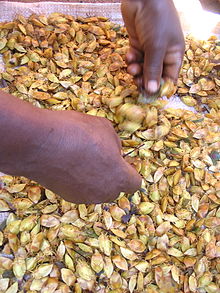Tessaratomidae
| Tessaratomidae | ||||||||||||
|---|---|---|---|---|---|---|---|---|---|---|---|---|

|
||||||||||||
| Systematics | ||||||||||||
|
||||||||||||
| Scientific name | ||||||||||||
| Tessaratomidae | ||||||||||||
| Stål , 1864 |


The Tessaratomidae are a family of bugs (Heteroptera) within the suborder Pentatomomorpha . About 240 species in 57 genera are known of them.
features
The large to very large bugs often become over 15 millimeters long. Their strongly built body is egg-shaped to elongated egg-shaped and is similar to that of the stink bug (Pentatomidae).
Their head is small, triangular and significantly narrower towards the tip than at the base. He's keeled sideways. The mandibles meet in the middle in front of the frontal plate ( clypeus ). The antennae are usually four-segmented, but there are also five-segmented types in which the third segment is very short. The labium is short and does not protrude beyond the hips ( coxes ) of the front legs. The pronotum extends beyond the base of the scutellum . The latter is triangular and does not obscure the corium of the hemielytras . On the hind wings there is a hamus (a hook-shaped cross vein in the disc cell, derived from the media). The wing veins of the membrane are not reticulated. The mesosternum is drawn forward to the side between the hips and forward onto the mesosternum. Usually it is preferred to a wedge pointing forward, which almost reaches the front hips and the rear edge of which is truncated at the connection to the abdomen. The outer part of the drainage organ of the olfactory glands of the metathorax has receded. The tarsi are bipartite or tripartite. Six pairs of spiracles can be seen on the abdomen, while the second abdomen segment on the sternum is completely exposed in most species. The aedeagus has up to four pairs of processes on the conjunctiva. The nymphs have dorsal scent gland openings on the terga of the third to sixth abdominal segment. Those between the third and fourth tergums are sometimes small and there is a small indentation between the sixth and seventh tergums.
The large body size, the protruding and enlarged, wedge-shaped metasternum, the free stigma on the second abdominal segment and probably also the strikingly colored nymphs characterize the family.
Occurrence
The family is most common in the tropics of the Old World. However, the widespread genus Piezosternum is also represented with three species in the Neotropic . The family is not represented in Europe.
Way of life
All previously known species are phytophagous . The preferred host plants are mainly rose-like (Rosales) and soap-tree-like (Sapindales), but many other groups of plants.
Economical meaning
The Tessaratomidae also include a number of species of economic importance for agriculture. So is z. B. Musgraveia sulciventris a pest in Australian citrus orchards. Another example is Tessaratoma papillosa , which is a serious pest on the lychee tree ( Litchi chinensis ) and longan ( Dimocarpus longan ) in China.
A number of species are collected for human consumption, e.g. B. Encosternum delegorguei in Zimbabwe and South Africa , species of the genus Pygoplatys and Tessaratoma papillosa and Tessaratoma javanica in Thailand, and Tessaratoma quadrata in Laos.
Taxonomy and systematics
The taxon was first described by Carl Stål in 1864. Leston viewed the group as a subfamily of the stink bugs, but later, like other authors, agreed to the family status that the group still holds today.
The following subfamilies, tribe and genera are assigned to the family:
Subfamily Natalicolinae
Subfamily Oncomerinae
Subfamily Tessaratominae
- Tribe Prionogastrini
- Sepinini tribe
- Subtribus Platytataria
- Sepinaria subtribe
- Tribe Tessaratomini
- Subtribus Eusthenaria
- Subtribe Tessaratomaria
- Notopomini tribe
Types (selection)
- Amissus testaceus Distant , 1909
- Encosternum delegorguei Spinola
- Mucanum patibulum Vollenhoven , 1868
- Musgraveia sulciventris ( Stål , 1863)
- Oncomeris flavicornis ( Guérin , 1831)
- Pycanum rubens ( Fabricius , 1794)
- Tessaratoma javanica ( Thunberg , 1783)
- Tessaratoma papillosa ( Drury , 1770)
- Tessaratoma quadrata Distant , 1902
supporting documents
Individual evidence
- ↑ a b c d Family Tessaratomidae. (No longer available online.) Australian Biological Resources Study. Australian Faunal Directory, archived from the original on April 7, 2014 ; Retrieved December 27, 2013 . Info: The archive link was inserted automatically and has not yet been checked. Please check the original and archive link according to the instructions and then remove this notice.
- ↑ a b Illustrated catalog of TESSARATOMIDAE. Philippe Magnien, accessed December 27, 2013 .
- ↑ a b c d e f RT Schuh, JA Slater: True Bugs of the World (Hemiptera: Heteroptera). Classification and Natural History. Cornell University Press, Ithaca, New York 1995, pp. 241ff.
- ↑ Tessaratomidae . Fauna Europaea. Retrieved February 1, 2017.
- ↑ DongXiang Zhao, J. Gao, Y. Wang, J. Jiang, R. Li: Morphology and Volatile Compounds of Metathoracic Scent Gland in Tessaratoma papillosa (Drury) (Hemiptera: Tessaratomidae). Neotropical Entomology, August 2012, Volume 41, Issue 4, pp. 278-282.
- ↑ CM Dzerefos ETF Witkowski, & R. Toms: Life-history traits of the edible stinkbug, Encosternum delegorguei (Hem, tessaratomidae.), A traditional food in southern Africa. Journal of Applied Entomology 2009, 133, pp. 739-759.
- ↑ Yupa Hanboonsong: Edible insects and associated foodhabits in Thailand. in Forest insects as food: humans bite back Food and Agricultural Organization of the United Nations, Regional Office for Asia and the Pacific, 2010 (online: PDF ).
- ↑ Somkhit Boulidam: Edible insects in a Lao market economy. in Forest insects as food: humans bite back Food and Agricultural Organization of the United Nations, Regional Office for Asia and the Pacific, 2010 (online: PDF ).
literature
- RT Schuh, JA Slater: True Bugs of the World (Hemiptera: Heteroptera). Classification and Natural History. Cornell University Press, Ithaca, New York 1995.